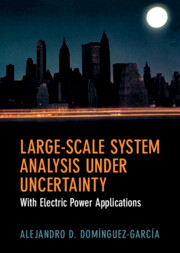Book contents
- Frontmatter
- Dedication
- Contents
- Preface and Acknowledgments
- Notation
- 1 Introduction
- 2 Preliminaries
- 3 Static Systems: Probabilistic Input Uncertainty
- 4 Static Systems: Probabilistic Structural Uncertainty
- 5 Discrete-Time Systems: Probabilistic Input Uncertainty
- 6 Continuous-Time Systems: Probabilistic Input Uncertainty
- 7 Static Systems: Set-Theoretic Input Uncertainty
- 8 Discrete-Time Systems: Set-Theoretic Input Uncertainty
- 9 Continuous-Time Systems: Set-Theoretic Input Uncertainty
- Appendix A Mathematical Background
- Appendix B Power Flow Modeling
- References
- Index
8 - Discrete-Time Systems: Set-Theoretic Input Uncertainty
Published online by Cambridge University Press: 17 January 2022
- Frontmatter
- Dedication
- Contents
- Preface and Acknowledgments
- Notation
- 1 Introduction
- 2 Preliminaries
- 3 Static Systems: Probabilistic Input Uncertainty
- 4 Static Systems: Probabilistic Structural Uncertainty
- 5 Discrete-Time Systems: Probabilistic Input Uncertainty
- 6 Continuous-Time Systems: Probabilistic Input Uncertainty
- 7 Static Systems: Set-Theoretic Input Uncertainty
- 8 Discrete-Time Systems: Set-Theoretic Input Uncertainty
- 9 Continuous-Time Systems: Set-Theoretic Input Uncertainty
- Appendix A Mathematical Background
- Appendix B Power Flow Modeling
- References
- Index
Summary
This chapter analyzes linear and nonlinear discrete-time systems described by a discrete-time state-space model whose inputs are uncertain but known to belong to an ellipsoid. For the linear case, even if the input set is an ellipsoid, the set containing all possible values that the state can take is not an ellipsoid in general, but it can be upper bounded by an ellipsoid. We develop techniques for recursively computing a family of such upper-bounding ellipsoids. Within this family, we then show how to choose ellipsoids that are optimal in some sense, e.g., they have minimum volume. For the nonlinear case, we will again resort to linearization techniques to approximately characterize the set containing all possible values that the state can take. The application of the techniques presented is illustrated using the same inertia-less AC microgrid model used in Chapter 5.
Keywords
- Type
- Chapter
- Information
- Large-Scale System Analysis Under UncertaintyWith Electric Power Applications, pp. 237 - 272Publisher: Cambridge University PressPrint publication year: 2022

